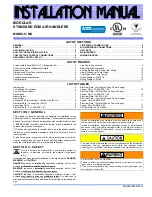
U-35
CHAPTER 3
•
General Technical Considerations
8.2 Comparing Static-type and Rotary-type Energy Recovery Units
Measure of useability
•
: High
o
: Average
× : Poor
Specification.
Static-type
Rotary-type
Construction/
Principle
Conductive transmission-type: cross-flow
Static-type transmission total energy recovery unit with
orthogonally layered honeycomb-shaped treated plates
formed into multiple layers.
•
As the supply air and exhaust air pass through different
passages (sequentially layered), the air passages are
completely separated.
Heat accumulation/humidity accumulation-
type: counterflow
The rotor core has honeycomb-shaped kraft paper,
etc., to which a moisture absorbent is applied (lithium
chloride, etc.). The rotor rotates, and heat
accumulation/humidity accumulation - heat discharge/
humidity discharge of total energy exchange is
performed by passing the exhaust and intake airflows
into a honeycomb passage.
× Supply air and exhaust airflows go into the same air
passage because of the rotary-type construction.
Moving Parts
•
None
Fixed core
× Rotor driven with belt by gear motor
Rotor core
Material Quality
Engineered resin composite
Plastic, aluminum plates, etc.
Prefilter
Required (periodic cleaning required
Required (periodic cleaning required)
Element Clogging
•
Occurs (State where dirt adheres onto the element air
passage surface; however, this is easily removed with a
vacuum cleaner.)
× Occurs (Dust is smeared into element air passage filter.)
(The dust adhered onto the core surface is smeared
into the air passage by the purge sector packing. It
cannot be removed easily and thus the air volume
decreases.)
Air Leakage
Gas Transmission
Rate
Approximately 2.5% air leak at standard fan position.
Leaks found on the air supply side can be reduced to 0
by leaking the loss air volume (approx. 10%) on the
exhaust side with the fan position to the core.
•
Gas transmission ( Ammonia
: approx. 2.9%)
In certified EATR on AHRI, Mitsubishi core EATR is
0%. Wheel types EATR are 0.04-7.7%.
× Purged air volume occurs
To prevent exhaust leaking to the air intake side, a purge
air volume (6 to 14%) leak is created on the exhaust side.
Thus, there are problems in the purge sector operation
conditions (pressure difference, speed), and the air
volume must be balanced.
× Gas transmission ( Ammonia
: 45-57%)
Bacteria Transmission
Rate
•
Low (Because air intake/exhaust outlets are separate,
transmission is low.)
× High (Because air intake/exhaust outlets are the same,
transmission is high.)
Bypass air pass for
comfortable season
Bypass circuit required (Permitted on one side of air
intake and exhaust air outlet passage)
Bypass circuit required (Required on both air intake
and exhaust air outlet sides)
(Theoretically, bypass operation is possible by stopping
the rotation, but the core will over-absorb and cause
serious damage.)
Maintenance
Core cleaning: More than once a year
The core surface will clog with lint and dirt, but
cleaning is easy with a vacuum cleaner.
Only the two core air passage intakes need to be
cleaned.
Core
cleaning: Once or twice a year
Cleaning is difficult as dust is smeared into core
by the purge sector packing.
× Gear motor for rotor drive
: Periodic inspection
× Rotor bearing, rotor drive belt
: Periodic inspection
Life
Core: Semi-permanent (10 years or more)
Static-type units do not break.)
Core: Semi-permanent (10 years or more)
(Periodic replacement is required because of the rotor
bearings and the core clogging.)
× Rotor drive belt
: Periodic replacement
× Drive motor, rotor bearing
: Periodic replacement
Model is
Available
o
Available from small to large.
o
Characteristic design of small and medium models are
possible.
Large models are easy to match to a machine room
layout.
Large type only
× Small models are difficult to design because of the
rotor magnitude.
Summary of Contents for Lossnay LGH-F1200RX5-E
Page 2: ...Y11 001 Jun 2012 MEE ...
Page 7: ......
Page 8: ...Lossnay Unit ...
Page 9: ......
Page 10: ...CHAPTER 1 Ventilation for Healthy Living ...
Page 23: ......
Page 24: ...CHAPTER 2 Lossnay Construction and Technology ...
Page 30: ...CHAPTER 3 General Technical Considerations ...
Page 45: ......
Page 46: ...U 37 CHAPTER 4 Characteristics CHAPTER 4 Characteristics ...
Page 59: ......
Page 60: ...CHAPTER 5 System Design Recommendations ...
Page 67: ......
Page 68: ...CHAPTER 6 Examples of Lossnay Applications ...
Page 79: ......
Page 80: ...CHAPTER 7 Installation Considerations ...
Page 83: ......
Page 84: ...CHAPTER 8 Filters ...
Page 90: ...CHAPTER 9 Service Life and Maintenance ...
Page 93: ......
Page 94: ...CHAPTER 10 Ventilation Standards in Each Country ...
Page 99: ......
Page 100: ...CHAPTER 11 Lossnay Q and A ...











































